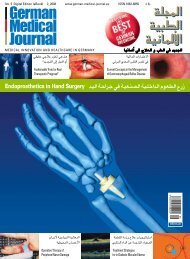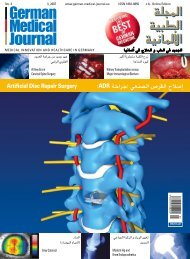جراحة الكبد - the German Medical Journal
جراحة الكبد - the German Medical Journal
جراحة الكبد - the German Medical Journal
Create successful ePaper yourself
Turn your PDF publications into a flip-book with our unique Google optimized e-Paper software.
Liver Surgery<br />
F E A T U R I N G T H E B E S T O F G E R M A N M E D I C I N E<br />
<strong>جراحة</strong> <strong>الكبد</strong><br />
and 89%, MRI and CT were<br />
superior to PET and to combbined<br />
PET/CT with a sensitivity<br />
of 54% and 66%, respectively<br />
(12)(Fig. 2).<br />
In addition to <strong>the</strong> aforementtioned<br />
examinations, magnetic<br />
resonance cholangiography<br />
(MRC) and endoscopic retroggrade<br />
cholangiography (ERC)<br />
are, if necessary, also empployed<br />
in <strong>the</strong> diagnosis of bile<br />
duct tumours (13). With a senssitivity<br />
of 94% and a specificity<br />
of 100%, MRC was superior to<br />
ERC with a sensitivity of 87%<br />
(14).<br />
For <strong>the</strong> final determination of<br />
<strong>the</strong> surgical strategy, many<br />
liver surgeons perform intraooperative<br />
ultrasonography<br />
following exploration of <strong>the</strong> site<br />
of surgery.<br />
With <strong>the</strong> help of intraoperative<br />
ultrasonography, <strong>the</strong> position<br />
of <strong>the</strong> tumour in relation to <strong>the</strong><br />
surrounding vessel structures<br />
can once more be precisely<br />
mapped (15).<br />
Currently, <strong>the</strong> results of inttraoperative<br />
ultrasonography<br />
alter <strong>the</strong> surgical approach for<br />
one in five patients (15). The<br />
development of 3-dimensional<br />
intraoperative ultrasonography<br />
is a novelty which enables ressections<br />
to be performed with<br />
greater precision while putting<br />
less strain on vessels and bile<br />
ducts (16).<br />
Prior to a planned extensive<br />
liver resection, <strong>the</strong> liver volume<br />
that remains after resection<br />
needs to be determined presurgically<br />
by means of radiology<br />
in order to assess <strong>the</strong><br />
functional capacity.<br />
This is done using novel<br />
software systems which are<br />
capable of segmenting intrahhepatic<br />
vascular and canaliicular<br />
structures, modelling<br />
<strong>the</strong>m three-dimensionally and<br />
quantitatively visualising <strong>the</strong>ir<br />
pertaining territory (17).<br />
With <strong>the</strong> help of computer<br />
programmes like MeVis, <strong>the</strong><br />
3-dimensional model of liver<br />
and vessels makes it possible<br />
to perform resections is such<br />
a way that parenchyma can be<br />
saved while reducing <strong>the</strong> surgiccal<br />
risk of hepatogenic insuffficiency<br />
(18).<br />
3. Indications<br />
Surgical intervention is currrently<br />
<strong>the</strong> only way to a full<br />
recovery from primary and<br />
increasingly also from secondaary<br />
malignancies of <strong>the</strong> liver.<br />
The indication for surgical treatmment<br />
of benign liver tumours<br />
results from complications<br />
(compression of neighbouring<br />
organs, pain, haemorrhage,<br />
etc.) or when <strong>the</strong>y are precanccerous<br />
(adenoma). The surgiccal<br />
treatment options are liver<br />
resection and transplantation.<br />
و %89 بالتتابع. وكانت اأفضل من<br />
PET و CT معاً الذان كانا %54<br />
و %66 على التوايل)2()12 .)Fig.<br />
بالإ ضافة اإىل الفحوص التي ذكرت<br />
فاإن تصوير الأ قنية الصفراوية<br />
بالرنني املغناطيسي وتصوير<br />
الأ قنية الصفراوية بالطريق الراجع<br />
.ERC اإذا كان رضوريان ميكن<br />
اإجراوؤهما يف تشخيص اأورام القناة<br />
الصفراوية )13(.<br />
حساسية %94 ونوعية %100 عند<br />
استعمال MRC مقارنة مع ERC<br />
الذي حساسيته % 87 .)14(<br />
من اأجل التحديد النهائي<br />
لالسرتاتيجية اجلراحية. يقوم<br />
جراحوا <strong>الكبد</strong> باإجراء الأ مواج<br />
الصوتية داخل العملية بعد الكشف<br />
عن موضع اجلراحة. حيث يتم<br />
مبساعدة الأ مواج الصوتية حتديد<br />
موقع الورم بالنسبة اإىل الأ وعية<br />
املجاورة حيث ميكن بدقة حتديد<br />
الورم )15(. حالياً حسب نتائج<br />
الأ مواج الصوتية فاإن القرار<br />
اجلراجي يتبدل يف مريض من اأصل<br />
خمسة مرضى )15(.<br />
اإن تطوير الأ مواج الصوتية ثالثية<br />
الأ بعاد واستعمالها داخل اجلراحة<br />
تسمح بالإ ستئصال الأ كرث دقة<br />
وتخفيف الضغط على الأ وعية<br />
الدموية والأ قنية الصفراوية )16(.<br />
قبل اإجراء الستئصال الواسع<br />
للكبد فاإنه يجب حتديد حجم<br />
<strong>الكبد</strong> املتبقي بعد الستئصال قبل<br />
اإجراء اجلراحة باستعمال الوسائل<br />
الشعاعية من اأجل تقيم القدرة<br />
الوظيفية. ويتم باستعمال برنامج<br />
خاص ميكن له اأن يعزل الأ وعية<br />
والأ قنية داخل <strong>الكبد</strong> ويٍ ظهر هذه<br />
الأ جزاء على شكل ثالثي الأ بعاد<br />
ويظهر حجمهم يف املناطق )17(.<br />
وباستعمال برامج كومييوتر مثل<br />
MeVis وباإظهار <strong>الكبد</strong> والأ وعية<br />
على شكل ثالثي الأ بعاد يجعل من<br />
املمكن اإجراء الستئصال للرباتشيم<br />
<strong>الكبد</strong>ي مع اإنقاص خطورة القصور<br />
<strong>الكبد</strong>ي )18(.<br />
3. االستطبابات:<br />
يعترب التداخل اجلراحي حالياً<br />
الطريقة الوحيدة للشفاء التام من<br />
اخلباثات البدئية وبشكل متزايد<br />
اأيضاً من اخلباثات الثانوية للكبد.<br />
اأن استطباب املعاجلة اجلراحية<br />
لالأ ورام <strong>الكبد</strong>ية السليمة يكون بسبب<br />
الختالطات )الضغط على الأ عضاء<br />
املجاورة، الأ مل، النزف اإلخ( اأو<br />
عندما تكون ماقبل رسطانية مثل<br />
الأ د ينوما. اإن خيارات اجلراحة<br />
تكون اإما بالستئصال اأو زرع<br />
<strong>الكبد</strong>. اإن قابلية اجلراحة مثالً:<br />
اإمكانية الستئصال الشايف للورم<br />
<strong>الكبد</strong>ي تعتمد على مدى غزوا<br />
الورم وامتداده ، حجم الستئصال<br />
الرضوري واحلجم <strong>الكبد</strong>ي الوظيفي<br />
املتبقي )19(.<br />
13 13













